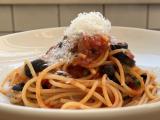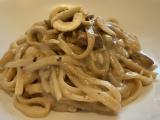- Climate-Friendly Cooking :carrot: /
- Recipes/
- Yotam Ottolenghi's Soba Noodles with Avocado, Lime, Cardamom and Pistachios/
Yotam Ottolenghi's Soba Noodles with Avocado, Lime, Cardamom and Pistachios
Table of Contents
Jump to Recipe
Jump to Carbon Footprint
Looking for a fresh main course for the summer? You’ve come to the right place!
This recipe is one of my favorites from Yotam Ottolenghi’s cookbook “Simple” (publisher’s website). It combines the freshness of basil and coriander with the tanginess of lime, the creaminess of avocado, the warmth of cardamom, and the crunch of pistachios—all perfectly paired with soba noodles. It’s a fantastic combination, especially on a hot summer day!
This recipe is not only delicious but also incredibly easy to make! ✌️ You can have everything ready in about 15 minutes and enjoy a flavorful meal. I prefer serving it lukewarm, allowing the soba noodles to cool slightly while preparing the sauce.

Soba noodles are made from buckwheat and originate from Japanese cuisine, where they are used in various dishes. They are thin, gray-brown, and slightly shorter than spaghetti. If you have an Asian market nearby, you’ll likely find them there; otherwise, they are available in well-stocked supermarkets. I highly recommend using soba noodles rather than substituting them with other types of Asian noodles such as ramen or rice noodles. The mild, nutty flavor of soba is truly unique.
Recipe #
Yotam Ottolenghi’s Soba Noodles with Avocado, Lime, Cardamom and Pistachios
15 minutes
2 servings
Ingredients #
- 100 grams soba noodles
- 15 grams fresh basil
- 15 grams fresh coriander
- 35 grams pistachios
- 1 organic lime
- 1 ripe avocado
- 2 tablespoons peanut oil
- 1 pinch of chili powder
- 1/4 teaspoon ground cardamom (or seeds from 6 cardamom pods)
- 1 pinch of salt
Directions #
- Cook the soba noodles according to the instructions on the packet. Drain and rinse with cold water, then set aside.
- While the noodles are cooking, prepare the sauce: Finely chop the basil, coriander, and pistachios. Wash the lime and finely grate some of the zest, avoiding the white pith. Squeeze the lime and reserve the juice. Slice the avocado into 1/2-centimeter-thick pieces.
- In a large bowl, combine the basil, coriander, pistachios, avocado, lime zest, lime juice, peanut oil, chili powder, and cardamom. Add the noodles and gently toss to combine. Season with a pinch of salt and serve immediately.
Carbon Footprint #
In total, two servings of soba noodles with avocado, lime, cardamom, and pistachios according to Yotam Ottolenghi have an estimated carbon footprint of 555 g.
This ranks it number 1 out of 57 recipes published on the blog so far in terms of estimated carbon footprint.
In other words, this is the recipe with the lowest climate impact published here! 🥇🥳At first glance, it may seem surprising that the avocado has a relatively good carbon footprint. In recent years, avocados have gained a reputation as “climate killers” due to the high water consumption for their production and often long transportation routes. However, these are only partial aspects of the overall carbon footprint. Most avocados are transported by ship or truck, resulting in a carbon footprint of approximately 0.2 kg CO2e per kg of avocado (source 1, source 2). While air-transported avocados have a significantly higher footprint, this is relatively rare. Here are two tips to avoid avocados transported by air:
- Avocados now grow in Europe, such as in Spain or Sicily. (In the US, most avocados come from Mexico.) Purchasing these increases the likelihood that they were transported by truck, reducing their carbon footprint.
- Avoid avocados harvested when fully ripe. Avocados continue to ripen after harvest, making them suitable for slower transportation methods like shipping. Fully ripe avocados often require faster air transport. While it’s difficult to confirm the harvesting method, firm avocados are more likely to have been shipped rather than flown in.
| ingredient | carbon footprint per kg | carbon footprint (in g) for 2 servings | % of ingredients | % of CO2 emissions |
|---|---|---|---|---|
| Soba noodles | 0.7 | 560 | 19% | 13% |
| Fresh basil | 1.0 | 3 | 3% | 3% |
| Fresh coriander | 1.2 | 1 | 3% | 3% |
| Pistachios | 2.3 | 3 | 7% | 15% |
| Organic lime | 1.9 | 2 | 17% | 31% |
| Avocado | 0.6 | 3 | 46% | 27% |
| Peanut oil | 0.9 | 1 | 6% | 5% |
| Chili powder | 1.1 | 38 | 0% | 0% |
| Cardamom | 1.1 | 192 | 0% | 0% |
| Salt | 1.4 | 7 | 0% | 0% |
| Cooking soba noodles | 3% |


